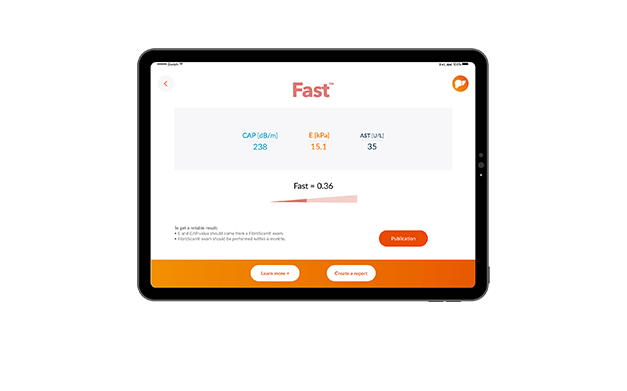With the alarmingly high prevalence of the asymptomatic disease, active fibrotic non-alcoholic steatohepatitis (NASH), coupled with the difficulties that clinical trial professionals face in identifying the most at-risk patients, the publication of a study supporting the use of FAST™ in The Lancet Gastroenterology & Hepatology could not be more timely:
“FibroScan-AST (FAST) Score For The Non-Invasive Identification of Patients With Non-Alcoholic Steatohepatitis With Significant Activity and Fibrosis: A Prospective Derivation and Global Validation Study” reviews a prospective study including 1,400 patients undergoing liver biopsy.
This publication demonstrates the value of FAST™ as a tool to enhance the diagnostic capabilities of healthcare providers to efficiently identify patients with a high probability of active fibrotic NASH.
Looming NAFLD-NASH Epidemic
Non-alcoholic fatty liver disease (NAFLD) is a condition in which fat builds up in your liver. The more severe form of NAFLD is called non-alcoholic steatohepatitis (NASH), an asymptomatic, progressive and burgeoning liver disease that can lead to increased liver-related mortality and morbidity. Data suggests that when a patient progresses to fibrotic NASH, their eight-year mortality rate increases to 35%, or a seven-fold increase over NAFLD alone. Moreover, people with Type II Diabetes have a 7-8 fold risk of advancing from NAFLD to fibrotic NASH.
Fortunately, NAFLD can be reversible if caught in the early stages, and innovative examination technology such as FibroScan and the FAST Score make it possible to quickly and non-invasively combat this disease.
FibroScan Based FAST™ Score Enhances the Role of FibroScan
The FAST™ Score is the newest enhancement to FibroScan, an innovative, FDA cleared non-invasive technology for the identification and monitoring of adult patients at risk of chronic liver disease. FibroScan is designed as a portable, point-of-care tool, to be operated by a medical assistant and interpreted by a healthcare professional.
Available on the MyFibroScan App, FAST amplifies the power of FibroScan to help clinicians cost-effectively identify individuals at risk for active fibrotic NASH. The test can be repeated periodically and is covered by most insurance plans, enabling routine monitoring of patients with probability scores below certain thresholds.
The Role of FAST™ Score
The FAST™ Score is not intended to replace clinical judgement, rather it is designed to provide additional insights by uniquely combining three components:
- Two physical biomarkers: liver stiffness by VCTE™ and liver fat through CAP™, two clinically validated biomarkers for estimating fibrosis and steatosis during a FibroScan examination.
- AST, a readily available blood marker of inflammation.
The FAST Score provides healthcare providers with an efficient, cost-effective tool to help non-invasively identify at-risk patients with progressive NASH – those individuals that merit consideration for further treatment or monitoring for progressive liver disease. The efficient identification of active fibrotic NASH has long been a challenge for drug companies, and many are now developing drugs targeting this disease.
- NASH is one of the leading causes of cirrhosisin adults living in the United States – up to 25% of adults with NASH may have cirrhosis.
- NASH tends to develop in people who are overweight or obese or have diabetes, high cholesterol or high triglycerides. However, some people have NASH even if they do not have any risk factors.
- Most people with NASH are between the ages of 40 and 60 years. It is more common in women than in men. NASH often has no symptoms and people can have NASH for years before symptoms occur.
FAST™ Score May Improve the Efficiency of Specialist Referrals and Reduce Invasive Testing
As many as 50% of the patients sent to biopsy were not appropriate candidates for clinical trials. Historically, there had been a high screen failure rate at liver biopsy because of the absence of such tools as the FAST Score. Going forward, the FAST score may not only reduce unnecessary specialist referrals and invasive tests, such as liver biopsies in patients unlikely to have significant diseases, but it will also help to more efficiently identify the patients suitable for clinical trials and emerging therapies.
An Epidemic by the Numbers
- Approximately 2 billion adults are obese or overweight and over 400 million have diabetes; both of which are risk factors for non-alcoholic fatty liver disease and hepatocellular carcinoma.
- Liver disease accounts for approximately 2 million deaths per year worldwide, 1 million due to complications of cirrhosis and 1 million due to viral hepatitis and hepatocellular carcinoma.
- Cirrhosis is currently the 11th most common cause of death globally and liver cancer is the 16th leading cause of death; combined they account for 3.5% of all deaths worldwide.
- Cirrhosis is within the top 20 causes of disability-adjusted life years and years of life lost, accounting for 1.6% and 2.1% of the worldwide burden.
Opportune Timing for FAST™ Score
This innovative, non-invasive point of care tool is needed to cost-effectively identify at-risk patients for the care they need. FAST can quickly and easily measure the amount of liver stiffness and fat to better stratify patients in need of more expensive or more invasive diagnostic procedures – saving time and resources for clinicians by eliminating patients not in need of additional assessment.
This score will also impact the development and introduction of several compounds to treat NAFLD and the liver complications of NASH, with the first agent anticipated later this year. These drugs will be expensive and may be able to reverse fibrosis in less than half of the patients treated. It is expected that over the next few years, the pharmaceutical treatment market for NAFLD could potentially reach $35 billion. Accurate, ongoing assessment of liver fat and stiffness will become even more critical in the anticipated prescribing of drugs.
